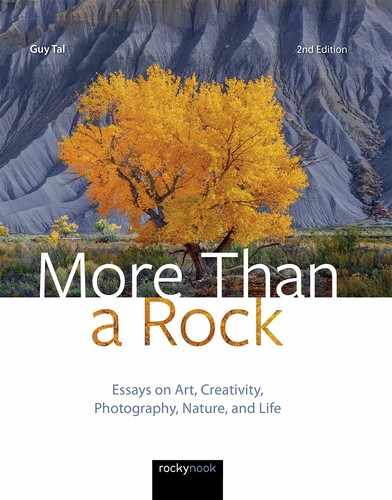67Aboutness
Look at the things around you, the immediate world around you. If you are alive, it will mean something to you, and if you care enough about photography, and if you know how to use it, you will want to photograph that meaningness.
—Paul Strand
I struggle to make meaningful images while traveling, especially in places that are new to me and/or where I feel like a casual visitor. In my work I strive to tell stories, and in order for me to be an effective storyteller I need to possess some intimate firsthand knowledge of my subjects—the kind of knowledge that can only come from a long-term relationship with them. Without such knowledge, the best I can hope for is to produce images that portray the external veneers of things and places, and that rely on aesthetics or interesting visual anecdotes rather than deeper familiarity.
I think it’s fair to say that the majority of photographs of natural things portrays objective appearances rather than subjective personal narratives rooted in deep personal familiarity. To me, this is a very important distinction in defining what I do, and how it differs from other uses of the photographic medium.
Rather than “photographer,” I often introduce myself as “photographic artist.” The main reason for doing so has little to do with either photography or art, but with the fact that most people have no preconceived notion of what a photographic artist is, and I get to explain.
Yes, I use photographic tools, and yes, I approach my work with the mindset of an artist; but a distinction often missed in such simplistic characterizations is how such an approach manifests in the end result: images. What makes an image expressive of the mind of the photographer, rather than a trophy for the photographer’s technical skills or the aesthetic appeal of the subject?
Expressive images transcend subject, location, light, and technique. These are all important but secondary to the goal of expressing something of the artist’s own mind. As Minor White put it, “One should photograph objects, not only for what they are, but for what else they are.” And the “else” is never inherent in the subject, it has to come from the creative mind and unique sensibilities of the person operating the camera; it’s what gives an image the elusive quality of aboutness: being not just a picture of something, but a picture about something.
Aboutness is what I struggle to express when working in places I am not familiar with, when working from the perspective of an outsider, or when I’m in a hurry or burdened by distractions—when I feel I have nothing to say about my experience that would be worth expressing. And yet, without it, it is unlikely I’ll be satisfied with the result, no matter how beautiful, colorful, detailed, or well composed.
To be sure, there may be worthwhile things to express about any experience, including such things as discomfort, alienation, or anxiety, which I feel in some situations, and that others may relate to. Alas, I don’t wish to dwell on such things in the course of making my work. My goal in art is to elevate my own experience, and the experiences of others.
After years of practice, I find that I have become more and more specialized and less of a generalist. I have become a firm believer in the value of self-imposed limitations. The more demanding I am of myself, the less likely I am to photograph, and yet the greater my satisfaction is with the images I do choose to make. Aesthetics alone no longer satisfy me; there has to be more to the story.
What may not be obvious is that such strict limitations also serve to liberate and enhance my experiences. When no meaningful image can be made, I am free to revel in feats of light and natural beauty for sheer joy, unencumbered by the camera. I have witnessed many breathtaking sunrises and sunsets, spectacular vistas, abundant beauty on every scale, without photographing them. I learned to enjoy things for what they are, separating the rewards of witnessing beautiful things from the joy of creating beautiful things that also express something of my own. When I have something to say, to create, to express—I may attempt to make a photograph about that thing; but in other times I prefer to listen, to enjoy, and to experience.

